Disclaimer: The picture above is one of my morning heart rate readings during the middle of my last marathon training cycle.
This week I decided to go a bit more practical and make the case for low heart rate training. I started experimenting with the MAF-method, one of the many versions of low heart rate training, just after my first marathon. Looking back at the work that went into finally breaking the three-hour marathon mark, I regret not starting my early running career with a focus on going slow. So, to all you excited readers out there I present the best advice I can give any runner looking to improve:
Low heart rate training is a slight variation on an age-old term in the endurance sports training philosophy: base training. Going all the way back to the works of famous New Zealander/running coach Arthur Lydiard, base training is commonly seen as the first part of any periodical training program. In order to achieve the peak fitness we desire come race day, it is important to start with the development of a sizeable aerobic base.
For the purpose of this post I will simplify the main theoretical concepts somewhat, but for those looking for some in-depth background, I refer to Canute’s comprehensive article on the link between aerobic and anaerobic fitness.
Behind any type of physical activity that makes you move, jump, run or wiggle, the biological supercomputer inside your head can rely on two very different energy systems:
1) The aerobic system, aka the powerful engine doing the bulk of the work.

Targeting the aerobic system has several benefits:
-
-
- Your slow-twitch muscle fibers are put to work. These are incredibly useful for activities that require endurance (e.g. marathon running, cross-country skiing or cycling) as they are most efficient at using oxygen to fuel your muscles.
- An increase in the number and size of your mitochondria, the aerobic sweatshops inside your body, lets your muscles produce energy more quickly.
- As your aerobic base grows, expect to see a lower resting heart rate. This is mainly because your stronger heart becomes more efficient at pumping oxygen-rich blood through your body. With this superpower also comes a reduced risk of heart disease.
-
2) On the other hand, there is the anaerobic system, aka your TURBO-modus.

Training the anaerobic system has the following benefits:
-
-
- Your fast-twitch muscle fibers are responsible for the explosivity and high power output needed to sprint up to 800 meters. Key point is that these fibers do not need oxygen to work, but instead rely on the residual chemical energy inside your muscles.For longer races, the strong finishing kick (looking at you Mo Farah) is the fruit of bittersweet anaerobic labor.
- An increase in muscle cell size due to a spike in human growth hormone will make your muscles stronger and faster.
-
The reason why David Rudisha can not sprint an entire marathon at his 800-meter world record pace lies partly in the ratio anaerobic/aerobic energy driving his performance.
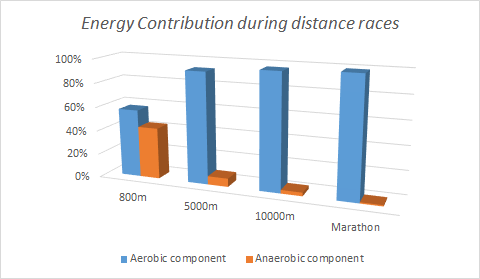
So in order to become better at distance running, we must spend the majority of our training time targeting the aerobic engine. How do we accomplish this?
Enter Dr. Phil Maffletone and his aptly named MAF-method (Maximum Aerobic Function)! From his article “Want speed? Slow Down!“, I gathered the following:
-
-
- Beginner runners or runners coming back from an injury often neglect to build a proper aerobic base. Instead, they tax their anaerobic system to fill the gaps which can lead to slower overall progress and a higher injury risk because the anaerobic system puts a higher stress on your body.
- In order to make sure athletes are exclusively training their aerobic system, a personal maximum aerobic heart rate limit should be imposed. The MAF-method puts this limit closely under or just at the maximum fat burning heart rate, or FATmax (yes this is a real thing), which is situated on the lower end of the aerobic spectrum.
- By using your optimal aerobic heart rate as an upper limit for the ENTIRE base training period (Dr. Maffletone suggests a minimum of 12 weeks), you will end up with a sexy solid aerobic base and turn your body into a fat incinerator.
- A heart rate monitor can be used to self-police infractions on the heart rate speed limit. Look for a watch that makes beep sounds to add some dramatic effect to every workout.
-
Calculating your MAF-heartrate
With the 180-formula from the article we can calculate our individual MAF-heartrate:
180 – (age) + (5 IF you have been injury free for at least two years/are under 25 years old) – (10 IF you have or recently had a major illness)
For me this meant:
180 – (25) + (5) => 160 is my MAF-Heart Rate!
Seeing as your heart rate can respond quickly to changes in terrain/temperature/stress levels/… subtract 10 beats of this MAF-Heart Rate to generate your very own training range (for me this is 150-160 bpm) wherein you will camp the next 12 weeks.
NOTE: To add some variety, I also did my shorter runs below 150 bpm as a true recovery run.
Base training schedule
Depending on your fitness, I would suggest following one of the following base building schedules based on Uncle Pete’s tiny bible to structure your pure MAF-training program:
- Beginners (“I haven’t run above 35km per week)-> click here
- Advanced (“I haven’t run above 55km per week)-> click here
MAF-test protocol
With your newly discovered maximum training heart rate and printed out training schedule, head to the nearest athletic track once every 4 weeks and do the following:
-
-
- Easy 15-20 minute warm-up jog
- 5-8 km running just under or at the MAF-heartrate (walk if needed to keep your heart rate under MAF)
- Take note of your kilometer split times and calculate the average min/km pace
- As a bonus, double-check your data to make sure your first test kilometer is the fastest and the last test kilometer the slowest. If not, warm up more and better next time.
-
Results of MAF-approach
The table below shows the results over time of all my MAF-tests.
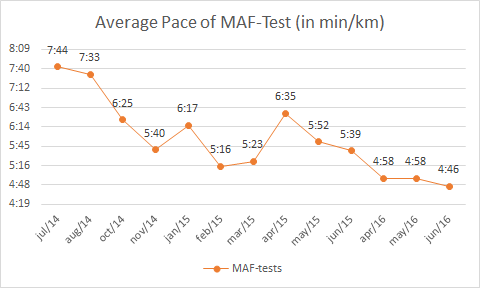
Couple of remarks:
- In the past two years, I have dropped nearly 3 full minutes (!) of my pace at MAF-heart rate (160 bpm) from a casual 7:44 min/km to a smooth 4:46 min/km.
- The setbacks in January and April of 2015 must be explained by an injury and a post-marathon running break. I strongly suggest staying committed to running as the fitness gains are relatively easy lost again.
- 2017 UPDATE: Last MAF-test before Buenos Aires Marathon (2h45) was 4:22 min/km average.
Transposing MAF to racing times
I found a very consistent relationship between lower MAF-averages and faster race times. This makes sense seeing as larger aerobic capacity should translate into better endurance.
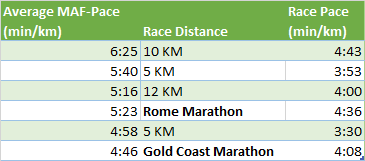
There is one final interesting relationship hidden in my data. By looking at the ratio between my Average MAF-Pace and the corresponding Race Pace, we can roughly identify the required aerobic component to complete different distance races:

If we compare these numbers with the Energy contribution graph from above, they seem to be rather low. If we take into account that MAF-training ignores the top end of the aerobic spectrum, the 15-20% difference can be reasonably explained. I am curious to see how these numbers will evolve in the future, seeing as with MAF people only seem to get faster as time goes by.
Tips & Tricks
To finish, here are some tips to cope with the soul-crushing boredom that goes with the start of your low heart rate training.

- STRIDES – Twice a week, cheat the system and finish your workout with 4-8 short 100m strides. Speed up to 90% of your top speed (you still need to be in control of your legs) for the first 70 meters then cruise the last 30 meters, jog or walk in between strides until you are fully recovered. Doing this will not only break up the monotony of running slow, it will also prime your neuromuscular system to become a more efficient runner.
- HILLS – Look to add some rolling hills to your running routes. While the uphills will most likely force you to walk/power hike to stay below MAF, downhill running at MAF-pace offers a chance to speed up and work on your running form.
- STEPS – Focus on maintaining a 180 steps-per-minute cadence is the easiest way to reinforce the natural or barefoot style of running which is currently regarded as the best way to run.
- TUNES – Music warps our perception of time, so use this to your advantage. I personally would go for music that is not too upbeat to keep you from speeding up ‘accidentally’ (Regina Spektor worked for me). Otherwise, podcasts are always good.
- DIET – Look into cutting refined carbohydrates from your diet will make you feel better and lose weight. A lighter runner has to work less hard to run fast! 😉
Run well,
Simon

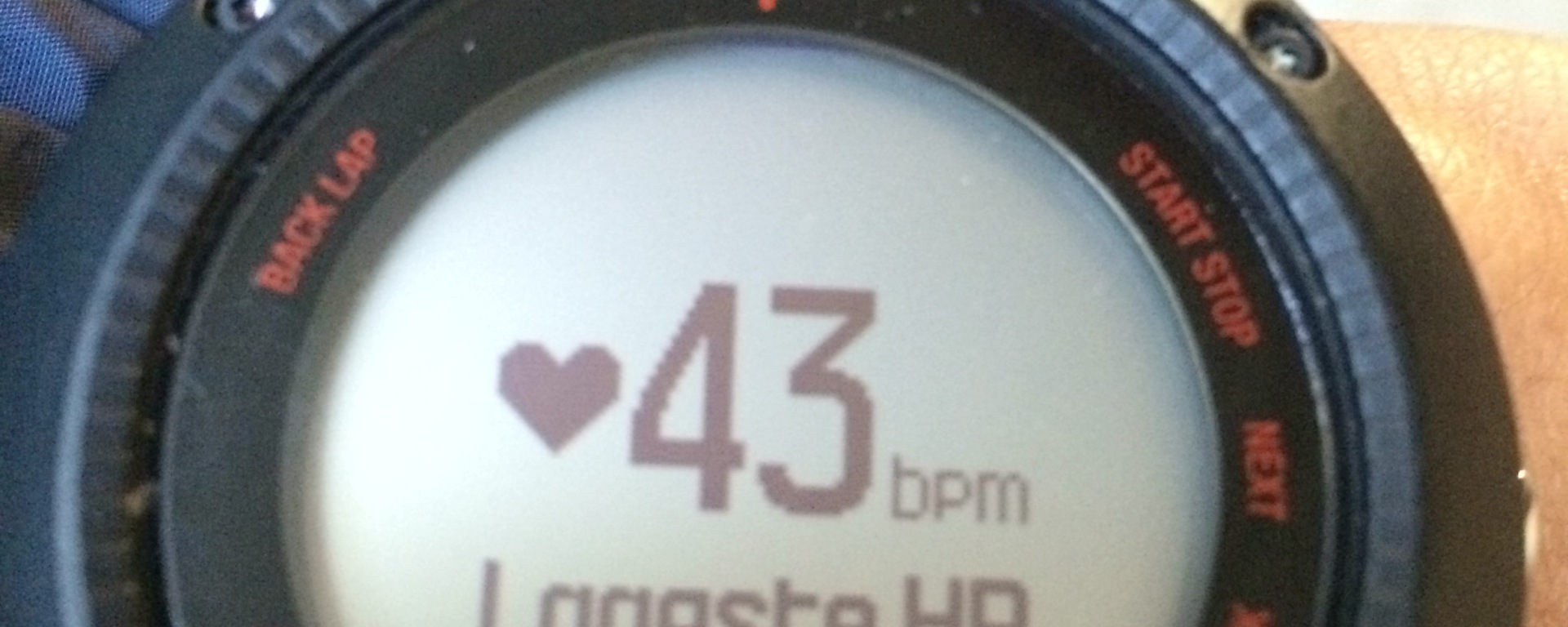
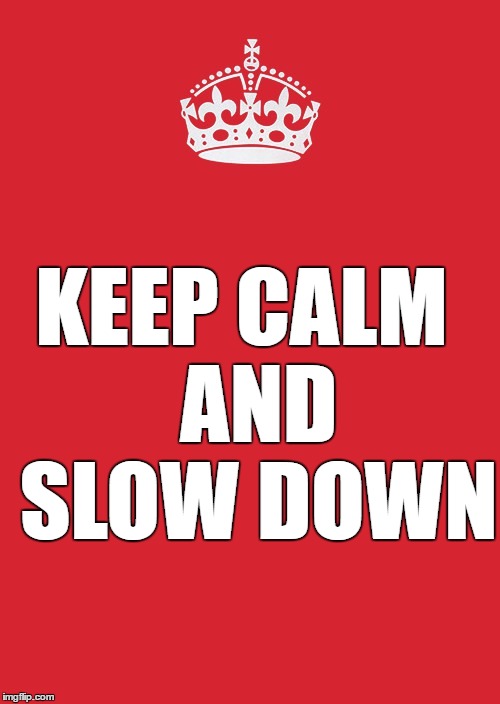
6 thoughts on “Running is heart work: An intro to low heart rate training.”